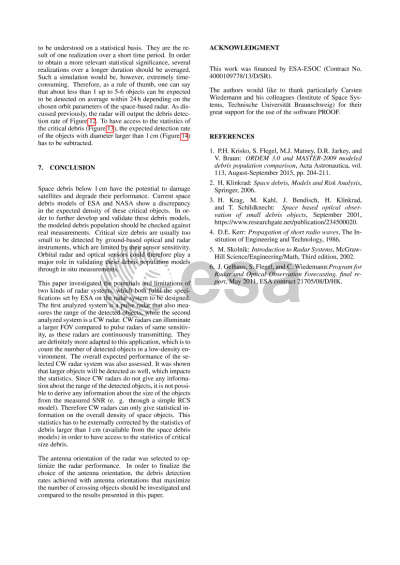Document details

Abstract
Presently, there exists very little knowledge about the density and distribution of space debris of the size of a few millimeters. The reason is that ground-based systems are not sensitive enough to detect such small objects. Space-based radars have the potential through in-situ measurements to validate or discard the current space debris models and to help filling this knowledge gap. This paper presents a preliminary design of a space-based radar for detecting mm-size space debris and discusses the potentials and limitations of such a concept.
The goal of the space-based radar to be designed is to detect and count the individual objects with a diameter of 1 to 5 mm at a range up to 500 m. The angular velocities of the debris of particular interest range between 0.1 deg/s and 10 deg/s with an average of 3 deg/s. The radar system mass should not exceed 10 kg. The maximum peak power is 50 W.
These specifications raise several questions, which should be answered by the investigation performed in this paper. Is it possible to design such a radar? In which frequency band should the radar operate? How should the signal processing be performed? What is the expected detection performance? What is the expected flux of debris according to ESA's model?
The paper will be organized as follows. The influence of the radar frequency on the occurring backscattering process will be investigated in section 2. Section 3 will discuss the influence of the antenna position on the expected radial and tangential velocities between space object and radar in order to select the most suitable antenna orientation. The chosen radar concept will be introduced in section 4 and will be discussed in section 5. Issues such as range and Doppler cell migration and their impact on the radar performance will be examined as well. Section 6 will investigate the expected flux of debris. Section 7 will summarize the analysis in order to assess the performance of this preliminary radar concept.
Preview













